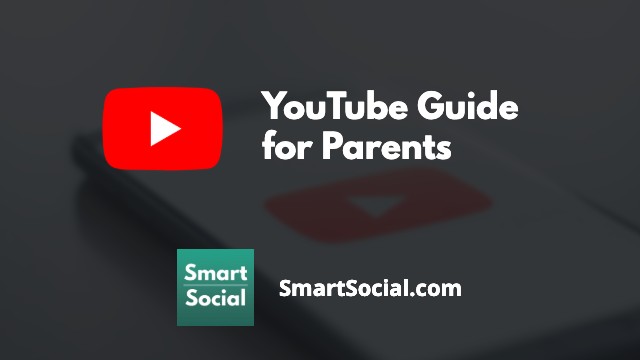How to Talk About Suicide and Depression with Your Students
Green Zone App
(Click here to learn more)
Dangerous Social media challenge
(Click here to learn more)
Red Zone App
(Click here to learn more)
Gray Zone App
(Click here to learn more)
The suicide rate among people ages 10 to 24 increased by nearly 60% between 2007 and 2018, according to the Centers for Disease Control and Prevention. Suicide is preventable and with the rising rates, it’s increasingly important for parents to talk to their children about difficult subjects like suicide, depression, and anxiety.

At SmartSocial.com, our focus is on keeping kids safe on social media, so we asked 11 professionals to share ways to talk with your family about the sadness associated with social media. These experts share everything from tips to managing sadness to age-appropriate talking points parents can use to start a discussion.
1. Don’t compare yourself to anything you see on social media - it isn’t real
Julia Katzman, LMSW, Teen Therapist, Plan Your Recovery

Parents need to be able to have honest conversations with their kids about the comparative nature of social media- it’s extremely controlled, and designed to make us feel as though our lives are incomplete.
Even though a lot of people recognize that social media isn’t real, it’s hard for kids to remember that when they're in the thick of it. Teen clients have told me they know that their friends post highly edited pictures, and they find it disturbing and wonder if that friend is lying, or trying to sell a fake version of themselves? And what does it mean to sell them a Facetuned, carefully captioned photo in return? Parents should bring up these topics when talking with their kids and empathetically listen to their responses.
But at the same time, social media gives us an extremely easy way to message and reach out to one another. For people who are really struggling, it can give them access to help. If someone is suicidal and they have access to a tool that allows them to quickly contact a friend, that’ll be a helpful way for them to reach out should their thoughts become overwhelmingly self-destructive. Social media can also be a powerful way to rally communities and spread information about important topics, which can also make us feel more united.
2. Talk about the positive side of social media
Lewis Keegan, Founder, SkillScouter.com

Talking to your kids about social media and the dangers it may bring if not used properly is the most important first step. Let them know social media can pressure them into becoming a person they are not and how it can lead them to live a life full of pretenses.
Remind them to be careful in the things they say and the things they share.
Social media can be used to spread good things and positivity when used correctly. Share with them positive social media posts and campaigns you’ve seen rather than only the ugly side of social media.
3. Make sure your kids know you’re there for them to talk to
Chris Norris, Managing Editor, SleepStandards.com

As a mental health professional, I know for a fact that being active on social media can lead to feelings of depression, anxiety, and other mental health conditions. Although social media plays a big part in helping you to keep in touch with your friends and loved ones who are far away, seeing posts related to current situations can worsen your stress and anxiety. Rumors and fake news about what’s happening around the world only cause people to panic.
For parents of toddlers and younger kids, you should limit your kid’s exposure to gadgets. If possible, use parental control features so even if you are not watching, you’re assured that your kids are not exposed to things they’re not supposed to see. For parents who have teenagers, you have to educate them on what social media can do to their mental health. You can let them know it’s okay to be active on social media to get the necessary social interactions they need but they have to always check if it’s affecting their mental health. For instance, if social media is making them feel frustrated and lonely, then it’s time to cut down a little and find something offline to do that would make them feel better about themselves. Encourage your kids to be open to you, so when they feel down and lonely, they can talk to someone and not only spend time on social media.
The Mayo Clinic explains teen suicide warning signs
Source: Mayo Clinic
4. Empower children by giving them all the information
Heinrich Long, Privacy Expert, Restore Privacy

The lack of privacy and protection online is a huge issue and one that affects children and teenagers disproportionately. If not addressed, online cyberbullying can, and has taken the lives of teenagers and even children. In order to prevent negative effects and even tragedies, parents should first of all, explain the online world to their kids. They need to be equipped with information on what sites and apps are appropriate vs. inappropriate, what kind of people they can interact with, and what is appropriate behavior for each category of person.
Most importantly, they need to be assured that they can come to you or any adult if they are ever made to feel sad, unwelcome, uncomfortable, depressed, suicidal, etc. Be calm and open with your children. Do not make it a story of doom and gloom and emphasize the fact that it’s not their fault and they won’t get in trouble for “telling on” the person who is making them feel uncomfortable.
If you establish trust with your child, they will feel comfortable coming to you with their issues. Social media can also be a place where children find resources to protect themselves from cyberbullying or a safe space for them to interact without the threat of harm.
5. Talk to your kids about their fear of missing out
Nicole Arzt, Licensed Marriage & Family Therapist, an advisory board member for Family Enthusiast

Social media can trigger intense feelings of FOMO - where children assume that everyone is living better and happier lives than they are. Additionally, social media places such a large emphasis on one's physical appearance - which can trigger feelings of insecurity and inadequacy. There's so much pressure to capture the moment rather than live in it.
Social media can also help people. Many people benefit from connecting with other like-minded individuals through message boards, forums, and websites. This sense of community can be invaluable, especially when it comes to needing to feel understood. It's important that parents discuss the pros/cons of social media and encourage having open conversations with their children. Social media isn't going anywhere- rather than fight it, we need to learn how to make it work for us.
6. Watch a documentary or program about depression or suicide to help open the conversation
Giuseppe Aragona, MD, General Practitioner

The best way to open these conversations with your children is to introduce it in a way they can interact with. The Social Dilemma is the perfect documentary on Netflix that quite eloquently describes the effect of social media - with information from experts and mixed with a fictional film running through it.
Engaging your family through watching this can help open the conversation to discuss different bits of useful information, and find out how your children feel about each of the effects discussed in the documentary and coming together to decide how you might need to all work together to change your usage in order for it to protect your mental health.
7. Have your child identify the positive and negative aspects of social media
Erica Wiles, Licensed Professional Counselor, QuickQuote.com

One of the best ways to begin these conversations is to be completely transparent, open, and honest. Children need to understand that while social media is great and often connects and entertains us, it can also cause a great deal of emotional and mental harm. Feelings of depression and suicidal ideation can and have occurred as a result of interactions on social media.
One of the best ways to approach this topic is to have an open conversation. Allow your children to identify both the positive and negative aspects of social media that they have either encountered or heard about. Have your own examples ready if need be. Help them clearly understand how triggers on social media can lead to upset feelings, depressed mood, and even suicidal ideation.
Make sure your discussion and explanations are clear, concise, and age-appropriate. Be sure to answer all questions. Ambiguity is not helpful in this situation. Do not shy away from talking about uncomfortable topics. Discussing self-harm and suicide with children can feel scary, but remember, knowledge is power.
Fostering this conversation can increase the likelihood that your children feel comfortable coming to you in the future if and when upsetting occurrences or negative strong feelings arise.
8. Teach your kids to surround themselves with positive people
Imani Francies, Certified Teacher, USInsuranceAgents.com

Young individuals are still developing and not quite adept to the hardships associated with success. They do not realize the good that people share masks many 'lows' that everyone experiences in life. Through their undeveloped lens, all students see is people leading a life that appears to be better than their own.
If students know how to remove themselves from environments that leave them feeling inadequate, they will be able to change what they interact with on social media. Here is how you can teach kids to surround themselves with positive people and environments:
- Model good friendship behavior
- Focus on characteristics that make a good environment and friend
- Talk about their own special qualities and how to recognize other's unique characteristics
- Teach them the golden rule: Treat others how you want to be treated
- Explore what a bad friend and environment is and does
- Talk about friendship expectations
Watch this episode as a video:
Listen to this episode on our podcast:
9. Share with your children your own feelings of sadness and how you manage it
Teodora Pavkovic, Psychologist and Parenting Coach, @PsycoachTP
As a psychologist and parenting coach focused on parenting in the age of technology from a strengths-based and emotionally literate perspective, addressing this topic is incredibly important.
Check your “H.A.L.Ts” (Hungry, Angry, Lonely and Tired). If you or any of your family members are in one (or more!) of these states, talk about the self-care you need first. Being in a H.A.L.T state reduces productivity and cooperation.

Explain to your family that emotions are our internal data. Our emotions let us know what is going on inside and outside of us, so that we can make changes accordingly. Emotions are also a kind of language; they are meant to be shared. Always encourage sharing.
It is very hard to say what causes an emotion. Your children shouldn’t fear using social media or being online, but the evidence thus far shows that some restrictions are necessary. Dr. Jean Twenge’s work suggests that tech-use in the excess of 5 hours/day is linked to a 71% greater likelihood of one suicide risk factor in teens. It’s also important for students to know that the online world does not equal the real world.
Share with your kids your own feelings of sadness, and the patterns you notice around them. Talk to them about how you deal with your sadness, and let them know you are here to listen and help in a non-judgmental way.
10. Remember that a child's top needs are to feel safe and loved
Dr. Carla Marie Manly, Clinical Psychologist
It is important to show your child your own genuine emotions (e.g., sadness), yet make sure that you, as the parent, talk to your child when you are in a calm, non-reactive state. Your child will pick up your emotions, so it's important to be sensitive to this issue.
Consider the setting and environment when talking to your children. Make sure that your children are not hungry or tired before having important discussions.
Be honest with your children, yet take care that the level of information imparted is age-appropriate.
Discuss the importance of reaching out for help when you are sad or feeling bad inside--no matter your age.
Make sure that you truly listen to any questions your children may have, making kind, gentle eye contact during discussions.
Use open-ended questions to check on your child. As an example, you might ask, "How are you feeling right now? What thoughts are you having?" Avoid questions that can be answered with a yes or no.
At the conclusion of your discussion, remind your children that you are available for any questions or thoughts that might arise.
It is VERY important that your children know that you, as the adult and caregiver, are safe. Your children may fear that if the parent is sad that suicide may be an option. Talk with your children at an age-appropriate level about your resources and how you cope with sadness. In other words, remember that a child's top needs are to feel safe and loved. Let your children know that they are safe and loved.
11. Remind your student that it’s okay to ask for help
Jodi Aman, Psychotherapist, @JodiAman
When parents want to discuss sensitive topics with their children, they should consider utilizing the talking points below.
- It's okay to ask for help
- Let your thoughts out. Negative thoughts can start to have a negative impact on you
- People are not who they appear to be online. Don't compare yourself to them
- Make an effort to connect to people in person. Take breaks from the news feed
- Engage in activities outside your comfort zone from time to time. Build trust in yourself
Conclusion
With so many resources available and so many people wanting to help, suicide can be prevented. Check on your friends and family members often and let them know you’re there for them. Let’s work towards getting rid of the stigma of talking about mental health.

If you or someone you know is in an emergency, call or text the Suicide & Crisis Lifeline at 988 or call 911 immediately. If you’re uncomfortable talking on the phone, you can also text HOME to 741-741 to be connected to a free, trained crisis counselor on the Crisis Text Line.
Protect your family and enter for a chance to win cool prizes
Become a member or log in to learn more on this topic
Protect your family and enter for a chance to win cool prizes

., start learning from this page to earn points!*
Hello, I'm Josh, the founder of SmartSocial.com.
Don't leave this page until you fill out our feedback form that will appear after you learn from the resources...
Here are some of the latest resources at SmartSocial.com
Become a Very Informed Parent (VIP) to get our social media suggestions in your email every Tuesday & Thursday.



Hello, I'm Josh, the founder of SmartSocial.com. Protect your family by taking my 1 minute quiz
This quiz will help you understand how safe your family is


Schools & Districts: Partner with us to protect your community online
Our remote presentations (and website) teach over a million parents and students each year how to be safe so they can shine online. We teach students how their accounts can be used to create a portfolio of positive accomplishments that impress colleges and employers.


Join Our Smart Social Podcast
each week on iTunes
With over 500 episodes, Josh Ochs interviews psychologists, therapists, counselors, teachers, and parents while showing you how to navigate social media to someday shine online.
Listen on:



.jpg)

.jpg)

_.jpg)
.png)